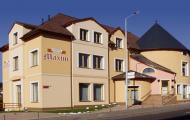Prague, which lies at the heart of Europe, is one of the most beautiful cities in the world. Known as the golden city of hundred spires, Prague has architectural splendors that span a thousand years. Medieval, Baroque and Renaissance building harmonically coexist on the streets of the Czech capital rendering the city its unique beauty and atmosphere. One can never get tired wandering around the winding streets of the Prague historical center.
Prague (population 1.25 million) has many names "Heart of Europe", "The city of hundred spires", "Northern Rome", "Eastern Paris", "Golden Prague", "Magical Prague". Newcomers will surely be astonished by the city's breathtaking beauty and architectural harmony, which will surely leave its lasting impression long after their departure.
The city is situated on the river Vltava which divides it into two parts. These parts are connected with 18 bridges. The city center comprises of five historical areas (Hradcany and Prague Castle, Mala Strana, Josefov, New Town with its busy and historic Wenceslas square) which since 1992 have been included in the UNESCO list of World Heritage Sites.
Apart from the historical sights Prague offers enormous variety of art galleries, museums, concert halls, theatres.
We recommend to visit!
If you plan to spend only one or-two days in Prague, we urge you to visit the following places as each of them are considered to be an absolute must see.
The Prague castle
The Prague castle, an ancient symbol of the Czech lands, is the most significant Czech monument and one of the most important cultural institutions in the Czech Republic. It is situated on a hill over the river Vltava. The Czech chronicler Kosmas compares the shape of the hill with a dolphin's back. The history of the castle began in the 9th century. The Prague Castle is made up of a vast array of palaces, monasteries, churches, defense towers and gardens. Inside the Prague castle you may walk along the Golden Lane, the so called "alchemist' s street". You can also find the residence of the President of the Czech Republic, where in the past Czech kings had originally lived. One of the most important cathedrals in Prague is St. Vitus Cathedral - an impressive gothic complex, where the Czech kings used to be coronated. It is also the place where the coronation relics - the symbol of the Czech statehood - are stored for safekeeping, And lastly , the remains of Czech kings can be found in the Cathedrals crypt below. One of the main buildings of the complex is the Royal Palace, where the Czech President swears an oath and on special occasions it is also the seat for Czech parliament.
From the side of Hradcanska square you can enjoy the breathtaking panorama of Prague and observe the changing of the guard of the Prague Castle.
Wenceslas square
The square was first concieved as a horse market in the 14th century when New Town was founded. It is the center of cultural, social and commercial life in Prague. The square, which resembles a wide boulevard with the numerous hotels, restaurants, café, bars, shopping centers, was also witness to two of the Czech Republic's most important historical events: "velvet revolution" of 1989, and soviet invasion of 1969.
National museum
Situated at one end of Wenceslas square, the National museum is one of the largest of 150 museums in Prague, it also happenst to be one of the city's oldest one as well. Founded in 1818, the famous Czech historian, Frantisek Palacky was particularly involved in the development and organisation of the museum. The main building was designed by neo-renaissance architect Josef Shulz. Outside, visitors will notice that the façade of the museum bears a resemblance the to the eastern façade of Louvre. Inside its halls, one will find pictures from Czech history and sculptures of the prominent personalities.
The Old city
The old royal city is one of the most developed and influential of Prague's districts, where today one can find a large number of historical monuments and architectural ensembles, which had been concentrated here: Charles bridge, Klementinum, Old Town square.
The first merchant and artisan settlements started to appear as early as the 10-11th centuries on the area which is today Old city, but officially, the founding is considered to be during the beginning of the 13th century, when separate settlements were united into one city surrounded by the city wall with ditches. Athough the walls are long gone, one can find traces of their existance, through the names of the some of the streets, where they used to stand. One street called "Na Prikope", which means "on the moat" in Czech, alludes to the moat over which the street was build. The center of this district is the Old Town Square.
The Old Town Square.
This is the historical city center with unique architectural memorials. At the center of the square is a statue devoted to a prominent Czech catholic priest and reformer, Jan Hus. The memorial was designed by Ladislav Saloun. In centuries past, this place with its beautiful architecture, was also witness to bloodshed. During the Hussites wars Jan Zelivsky, the commander of the radical hussites, was executed in 1422. His successor, commander Jan Rohac and his 53 battle companions, who were no more fortunate than Zelivsky, and were also executed on this very same spot. In 1621 the victorious Catholic emperor severely punished the protestants: 27 rioters were beheaded at the Old Town Square. The cross in front of the Town Hall marks the place of the scaffold.
Charles Bridge
Footbridge across the Vltava that connects Mala Strana and The Old Town parts of the city is a well-known gathering for tourist from around the world. The bridge, which is decorated with 24 sculptures of saints, is a great place to buy souvenirs and to listen to the street musicians.
National theatre
Don't forget your evening dress if you want to see opera or ballet in this famous theatre. It is recommended to order the tickets in advance, which can be done by telephone at our hotel or with the help of a tourist agency
Vysehrad
According to Czech legends Vysehrad is regarded as the cradle of the Czech nation, It from here that the legendary first Czech princess, Libuse foresaw the future glory of Prague from Vysehrad's cliff. But according to the historical chronicles Vysehrad fortress dates back to the 10th century, by which time Prague already existed and the Prague castle had already been founded. Main attractions of Vysehrad are St. Martin's rotunda, the mysterious "devil's stone", and of course neo-gothic church of SS Peter and Paul. Vysehrad also holds a national cemetery, where many famous Czechs are buried.
Prague Jewish Quarter
The former Jewish ghetto in Prague has a long history dating back to the 12th century, when the fist Jewish settlements appeared in the Old city. By the 17th Century, there were 7000 people living in this area, whose inhabitants were subject to constant persecution from anti-Jewish pogroms. In 1850 this section was incorporated into Prague as the fifth town and was named Josefov. But soon afterwards, affluent Jews moved to the other districts of Prague and this area became a place for the poor. Falling into gradual decline, with hygienic conditions worsening, a decision was taken in the 19th century to have the district destroyed and rebuilt with new buildings. The only buildings remain of the old Jewish quarter are six synagogues. The most famous sights are the Old New Synagogue (Staronova synagoga) built in the 13th century and Jewish town hall with a clock whose hands move backwards. The most impressive place of Josefov is the old Jewish cemetery which is the oldest surviving Jewish cemetery in Europe. The number of visible tombs is 12,000 but there may have been as many as 100,000 burials in all.
Saint Jan under the rock.
Saint John under the Cliff is one of the most picturesque villages in the natural reserve, "Czech Kras". The history of the settlement dates back to the 9th century when, according to legend, the first Czech Christian hermit, Ivan, settled in a cave under the cliff, which has been preserved to this day, can be found hidden behind a church. In the wall adjacent to the cave, there is an entrance into the cave. In the 17th century the church was rebuilt into the cloister carved out of the rocks of the cliff.
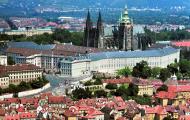 |
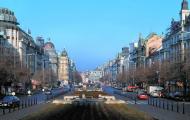 |
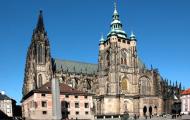 |
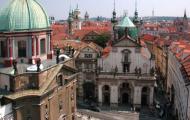 |
 |
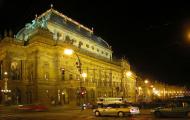 |
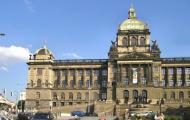 |
 |
